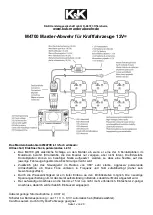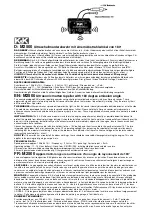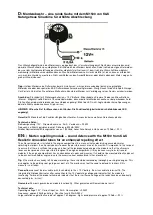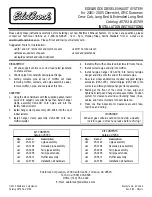
WSM. 124
·
Section N (Elec. Equip.)
To obtain specific
gravity
(corrected to 60
°
F.
(/·56°C.)
of:
1 ·260 (Climates below
80
°
F. (26·7
°
C.)
1 ·210 (Climates above
80
°
F. (26·7
°
C.)
Add
1
vol.
of
acid
of
1·835 S.G.
(corrected to 60
°
F.
(/ ·56
°
C.)
to:
3·0 volumes of water
4·0 volumes of water
Heat is produced by the mixture of acid and water,
and the electrolyte should be allowed to cool before
taking hydrometer readings-unless a thermometer
is used to measure the actual temperature, and a
correction applied to the reading as previously
described-and before pouring the electrolyte into
the battery. The total volume of electrolyte
required Is 4½ pints (2·66 litres) for BT 7A batteries
and 7½ pints (4·3 litres) for BY 11A batteries.
(a) UNCHARGED BATTERIES
Filling the Cells
The temperature of the acid, battery and filling-In
room must be not below 32
°
F. (0
°
C.). Carefully
break the seals in the filling holes and half fill each
cell with electrolyte of the appropriate specific
gravity. Allow the battery to stand for at least six
hours, In order to dissipate the heat generated by
the chemical action of the acid on the plates and
separators, and then add sufficient electrolyte to
fill each cell to the top of the separator guard.
Allow to stand for a further two hours and then
proceed with the Initial charge.
Initial Charge
The Initial charging rate Is 2·5 amperes for BT 7A
batteries and 3·5 amperes for BV9-11A batteries.
Charge at this rate until the voltage and specific
gravity readings show no increase over five
successive hourly readings. This will take from 40
to 80 hours, depending on the length of time
the battery has been stored before charging.
Keep the current constant by varying the series
resistance of the circuit, or the generator output.
This charge should not be broken by long rest
2nd
re-issue
Page S
periods. If, however, the temperature of any cell
rises above maximum quoted:
Climate below 90
°
F. (32
°
C).
Climate above 90
°
F. (32
°
C).
100
°
F· (38
°
C).
120
°
F. (49
°
C).
The charge must be Interrupted until the tempera
ture has fallen at least 10
°
F. (6
°
C.) below that
figure. Throughout the charge the electrolyte must
be kept level with the top of the separator guard
by the addition of more electrolyte as required.
At the end of the charge carefully check the specific
gravity In each cell to ensure that, when corrected
to 60
°
F. (15·6
°
C.), It lies within the specific limits.
If any cell requires adjustment, some of the
electrolyte must be syphoned off and replaced
either by distilled water or by acid of the strength
originally used for filling-In, depending on whether
the specific gravity Is too high or too low. Continue
the charge for an hour or so to ensure adequate
mixing of the electrolyte and again check the
specfic gravity readings. If necessary, repeat the
adjustment process until the desired reading Is
obtained in each cell. Finally, allow the battery to
cool and syphon off any electrolyte above the
tops of the separators.
(b) "DRY-CHARGED" BATTERIES
Electrolyte of the appropriate specific gravity, either
1 ·270 or 1 ·210, Is prepared as previously described.
Filling the Cells
Carefully break the seals or remove the tape (as
applicable) and fill each with electrolyte to the tops
of the separators, in one operation. The tempera
ture of the filling room, battery and electrolyte
should be maintained between 60
°
F. (15·6
°
C.) and
100
°
F. (38
°
C.). If the battery has been stored in a
cool place It should be allowed to warm up to
room temperature before filling.
Batteries filled in this way are 90 per cent.
charged and may be used after a standing
period of one hour. When time permits,
however, a short freshening charge will ensure that
Summary of Contents for ALPINE I SERIES: APLINE II SERIES
Page 1: ......
Page 189: ...Fis 21 Ball pin heirht checkinr fixture in position Details of items 1 to 4 In Fig 22...
Page 208: ...Fla 3 Exploded view of rear axle Hypoid Bevel Drive...
Page 220: ...Page 16 WSM 12 f Section G Rear Axle 0 QQ I I I I I t 0 ii 8 ts t 0 Cl 2 i J...
Page 247: ...Page6 WSM 124 Section J Steering N Iii it...
Page 299: ...Page 40 3 6 7 8 Fis 22 Se rvo unit exploded view Sect WSM 124 ion K Brakes 18 419 GZo 21...
Page 413: ..._ PRINTED IN ENGLAND 9Y WREN PRINTING CQ LTD LONDON...
















































